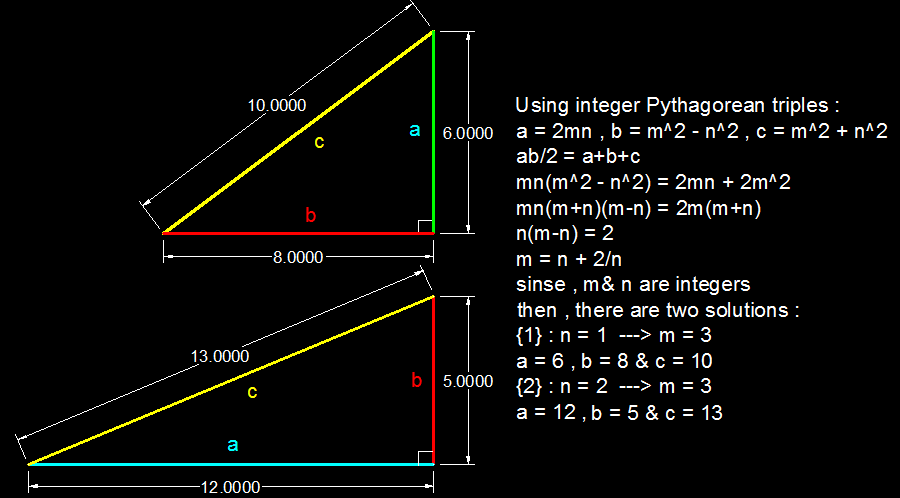How many right triangles with integer sides are there?
How many right triangles with integer sides are there where the area and perimeter of the triangle have the same numerical value?
The answer is 2.
This section requires Javascript.
You are seeing this because something didn't load right. We suggest you, (a) try
refreshing the page, (b) enabling javascript if it is disabled on your browser and,
finally, (c)
loading the
non-javascript version of this page
. We're sorry about the hassle.
3 solutions

Nice solution. I took a slightly different approach. I started with the condition equation
2 a b = a + b + a 2 + b 2 ⟹ a b − 2 ( a + b ) = 2 a 2 + b 2 .
Squaring both sides gives us that
− 4 a b ( a + b ) + ( a b ) 2 + 4 ( a 2 + b 2 + 2 a b ) = 4 ( a 2 + b 2 ) ⟹ a b ( a b − 4 a − 4 b + 8 ) = 0 .
Since a b = 0 we have that a b − 4 a − 4 b + 8 = 0 ⟹ ( a − 4 ) ( b − 4 ) = 8 .
Considering the factorizations of 8 we can have a − 4 = 1 , b − 4 = 8 ⟹ ( a , b , c ) = ( 5 , 1 2 , 1 3 ) , or we can have a − 4 = 2 , b − 4 = 4 ⟹ ( a , b , c ) = ( 6 , 8 , 1 0 ) .
If the sides of the right triangle are x , y , x 2 + y 2 ∈ N , then we wish to compute:
2 1 ⋅ x y = x + y + x 2 + y 2 ;
or [ 2 1 ⋅ x y − ( x + y ) ] 2 = x 2 + y 2 ;
or 4 1 ⋅ x 2 y 2 − x 2 y − x y 2 + x 2 + 2 x y + y 2 = x 2 + y 2 ;
or 4 1 ⋅ x 2 y 2 − x 2 y − x y 2 + 2 x y = 0 ;
or x y ( 4 1 ⋅ x y − x − y + 2 ) = 0 .
In order for the above product to hold true, we require 4 1 ⋅ x y − x − y + 2 = 0 ⇒ y = 4 + x − 4 8 . This requires the positive integer pairs: ( x , y ) = ( 5 , 1 2 ) ; ( 6 , 8 ) ; ( 8 , 6 ) ; ( 1 2 , 5 ) , which yields only the 5 − 1 2 − 1 3 and the 6 − 8 − 1 0 right triangles as solutions.
Examining Pythagorean triples, 3-4-5, 6-8-10, 5-12-13, 8-15-17, 9-12-15, we see 2nd and third ok. From the fourth the area is much more than the perimeter. So only two solutions. Here this method is much shorter than the use of theory.